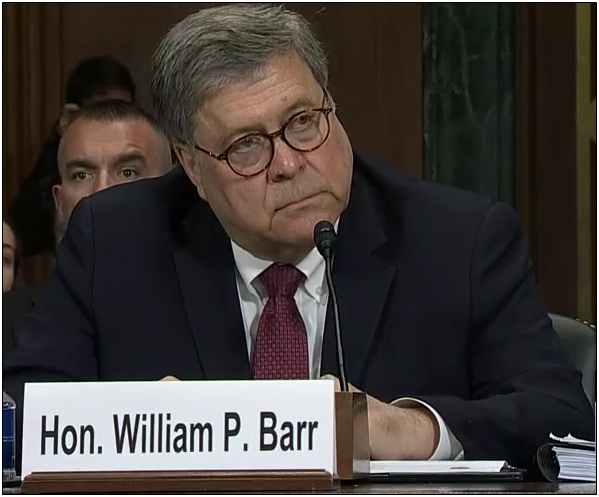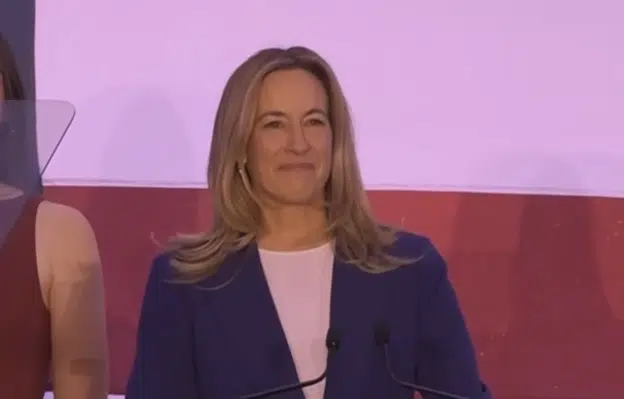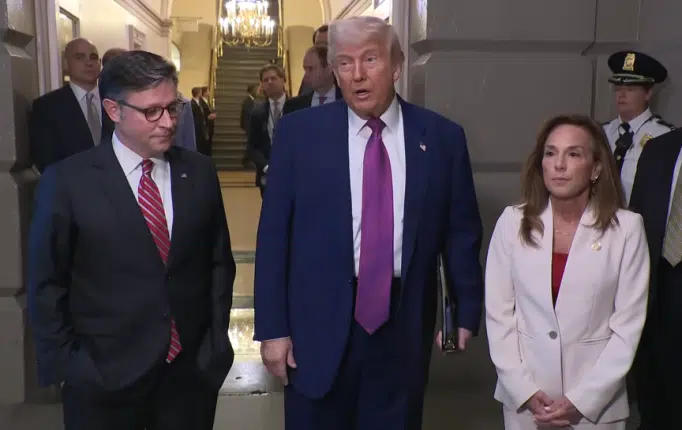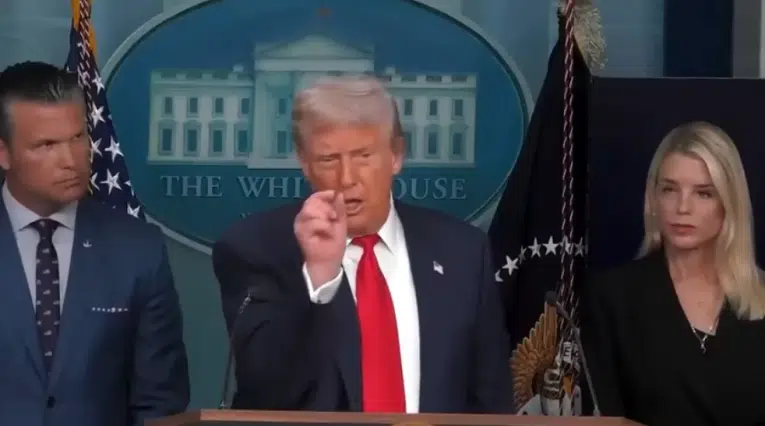Without a conspiracy with Russia to interfere in the election, there was no obstruction of justice by President Donald Trump when he considered removing Robert Mueller as special counsel.
That is one of the key takeaways from Attorney General William Barr’s testimony before the Senate Judiciary Committee on May 1 that everyone should take into account on the question of obstruction, as he took questions from Ranking Member Dianne Feinstein (D-Calif.).
In it, Barr acknowledged that, like the firing of James Comey from FBI director, Trump also has the power as the President under Article II of the Constitution to remove other inferior officers of the executive branch, including a special counsel. Barr stated, “as a matter of law, the Department’s position would be that the President can direct the termination or replacement of a special counsel.”
For those who need a refresher, under Article II, Section 1 of the Constitution, it clearly states “The executive power shall be vested in a president of the United States of America.” That clearly makes the President in charge of all proceedings of the executive branch, including the power to remove lower officials there.
Section 2 covers appointments subject to Senate confirmation but does not discuss removal. That was always thought to be an inherent power of the executive under Section 1, going all the way back to 1789 when Congress considered the creation of a Department of Foreign Affairs and the question came up. At the time, James Madison said, “Gentlemen have all along proceeded on the idea that the Constitution vests the [removal of executive branch officials] power in the President…”
This was further settled in the 1926 Supreme Court decision Myers v. United States, with Chief Justice William Howard Taft writing, “The view of Mr. Madison and his associates was that not only did the grant of executive power to the President in the first section of article 2 carry with it the power of removal, but the express recognition of the power of appointment in the second section enforced this view on the well-approved principle of constitutional and statutory construction that the power of removal of executive officers was incident to the power of appointment.”
So, clearly, the President has the power to remove executive branch officials. That includes Trump, for those who still have not accepted the outcome of the 2016 election. Trump could have fired Mueller if he wanted to.
And, considering the circumstances, where Mueller was leading an investigation into crimes — conspiracy with Russia to interfere in the elections and being a Russian agent — that the President never committed, the President would have had a pretty solid rationale.
Barr noted, “If the President is being falsely accused, which the evidence now suggests that the accusations against him were false, and he knew they were false, and he felt the investigation was unfair, propelled by his political opponents and was hampering his ability to govern, that is not a corrupt motive for replacing an independent counsel.”
Later, Barr put a finer point on this, telling Sen. Patrick Leahy (D-Vt.), “In the case of a president, who has the constitutional authority to supervise proceedings, if, in fact, a proceeding was not well-founded, if it was a groundless proceeding, if it was based on false allegations, the President does not have to sit there constitutionally and allow it to run its course. The President could terminate that proceeding and it would not be a corrupt intent because he was being falsely accused and he would be worried about the impact on his administration.”
Barr added, continuing, “That’s important because most of the obstruction claims that are being made here, or episodes, do involve the exercise of the President’s constitutional authority and we now know that he was being falsely accused.”
The issue at question was a June 2017 encounter Trump reportedly had with then-White House Counsel Don McGahn wherein Trump said, per McGahn’s recollection: “Call Rod [Rosenstein], tell Rod that Mueller has conflicts and can’t be the Special Counsel.”
McGahn never made that call and later news accounts, beginning in Jan. 2018, suggested that Trump had demanded that McGahn fire Mueller. Trump disputed that version of the account, saying the directive was to call Rosenstein and raise the potential conflict of interest, and directed McGahn to issue a correction but McGahn refused. That is all in the Mueller report beginning on page 113 of volume 2.
Off the bat, the directive could be taken in the sense the President suggested, which is that it was not an order to fire per se but to raise the conflict of interests with then-Deputy Attorney General Rod Rosenstein, who oversaw Mueller and was in a position to remove him. If the President had not ordered that Mueller be fired, then he would be rightly concerned that McGahn had told the special counsel that he had, and that his interrogation relating the faulty recollection had then been reported in the newspapers.
On the other hand, it is easy to see why McGahn saw it as an effort by the President to outright remove Mueller.
On that point, if the directive was to fire Mueller, then why not direct McGahn to draw up a short letter directly to Mueller terminating the appointment, the same way former FBI Director James Comey was fired? Why go to Rosenstein?
The answer lays in the federal regulation, 28 CFR § 600.7, stating that one way a special counsel can be removed is by the acting Attorney General — in this case that was Rosenstein — for cause. It highlights a conflict of interest as a potential cause for removal, stating, “The Special Counsel may be disciplined or removed from office only by the personal action of the Attorney General. The Attorney General may remove a Special Counsel for misconduct, dereliction of duty, incapacity, conflict of interest, or for other good cause, including violation of Departmental policies. The Attorney General shall inform the Special Counsel in writing of the specific reason for his or her removal.”
So, if Trump thought there was a conflict of interest that might necessitate Mueller’s removal or replacement, Rosenstein was absolutely the right person to talk to about that. Under that regulation, the acting Attorney General makes the call.
Even Mueller’s report cites McGahn with a similar understanding that the directive was to talk to Rosenstein, stating, “McGahn understood the President to be saying that the Special Counsel had to be removed by Rosenstein.”
Mueller neither charged nor recommended that Trump be charged with obstruction on either the count of telling McGahn to talk to Rosenstein about removing Mueller, nor for asking McGahn to correct the record about his recollection of the conversation he had with the President.
Now we also know Barr’s thoughts on the matter, too, which is that the President was still acting within the scope of his own authority and the regulation, and that even if Rosenstein had agreed there was a conflict of interest, the result would not have ended the investigation, it would have just meant that a new special counsel would be named. Either way, the subject of a special counsel investigation has the right to say there is a conflict of interest with the special counsel’s supervisor, Rosenstein, and the Mueller report also documents that Trump’s personal attorney had called Rosenstein as well to articulate that Mueller had a conflict of interest. McGahn would have just been one more voice urging Rosenstein to look at the conflict of interest. Ultimately, Rosenstein determined there was no conflict of interest preventing Mueller from completing the investigation.
In this case, the subject of the investigation was the President of the United States who also had the power to fire Mueller directly, and since the investigation was in part whether the President was a Russian agent, a false allegation, he would have had cause. That is not a corrupt intent to obstruct justice, it was a potential consideration of preventing a miscarriage of justice, since at the time the President did not know if he would be charged with crimes he did not commit that would further hamper his ability to do his job.
Consider the nuclear security issues the President contends with daily, with sensitive negotiations with North Korea on denuclearization that recently broke off the same day Trump’s former attorney Michael Cohen was called to testify in Congress. The Intermediate Nuclear Forces Treaty with Russia was recently terminated as well. Perhaps deals could have been made to halt nuclear proliferation, but because of the investigations, Trump was thought to be a lame duck by his foreign counterparts. A compelling case can be made that the unfounded investigation of the President’s allegiance has hampered his ability to negotiate on nuclear proliferation, making the world less safe.
In the end, President Trump never fired Special Counsel Mueller. He asked White House Counsel McGahn that a potential conflict of interest be raised with then-acting Attorney General Rosenstein, which was his right and within the scope of the regulation that permits the acting Attorney General to remove the special counsel for cause including a conflict of interest. And if his understanding of his conversation with McGahn differs from McGahn’s, since the directive could be taken either way, then that is not proof beyond a reasonable doubt that Trump wanted to do anything other than correct the public record about what his directive meant. If this was the core of the obstruction case Democrats want to make against Trump, Barr just demolished it.
Robert Romano is the Vice President of Public Policy at Americans for Limited Government.







